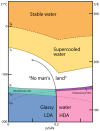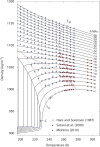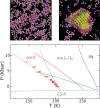Water: A Tale of Two Liquids
- PMID: 27380438
- PMCID: PMC5424717
- DOI: 10.1021/acs.chemrev.5b00750
Water: A Tale of Two Liquids
Abstract
Water is the most abundant liquid on earth and also the substance with the largest number of anomalies in its properties. It is a prerequisite for life and as such a most important subject of current research in chemical physics and physical chemistry. In spite of its simplicity as a liquid, it has an enormously rich phase diagram where different types of ices, amorphous phases, and anomalies disclose a path that points to unique thermodynamics of its supercooled liquid state that still hides many unraveled secrets. In this review we describe the behavior of water in the regime from ambient conditions to the deeply supercooled region. The review describes simulations and experiments on this anomalous liquid. Several scenarios have been proposed to explain the anomalous properties that become strongly enhanced in the supercooled region. Among those, the second critical-point scenario has been investigated extensively, and at present most experimental evidence point to this scenario. Starting from very low temperatures, a coexistence line between a high-density amorphous phase and a low-density amorphous phase would continue in a coexistence line between a high-density and a low-density liquid phase terminating in a liquid-liquid critical point, LLCP. On approaching this LLCP from the one-phase region, a crossover in thermodynamics and dynamics can be found. This is discussed based on a picture of a temperature-dependent balance between a high-density liquid and a low-density liquid favored by, respectively, entropy and enthalpy, leading to a consistent picture of the thermodynamics of bulk water. Ice nucleation is also discussed, since this is what severely impedes experimental investigation of the vicinity of the proposed LLCP. Experimental investigation of stretched water, i.e., water at negative pressure, gives access to a different regime of the complex water diagram. Different ways to inhibit crystallization through confinement and aqueous solutions are discussed through results from experiments and simulations using the most sophisticated and advanced techniques. These findings represent tiles of a global picture that still needs to be completed. Some of the possible experimental lines of research that are essential to complete this picture are explored.
Conflict of interest statement
The authors declare no competing financial interest.
Figures






























References
-
- Angell C. A. In Water: A Comprehensive Treatise; Franks F., Ed.; Plenum: New York, 1982; Vol. 7.
-
- Debenedetti P. G.Metastable Liquids: Concepts and Principles; Princeton University Press: Princeton, 1996.
-
- Franks F.Water: A Matrix of Life; Royal Society of Chemistry: Cambridge, 2000.
-
- Debenedetti P. G. Supercooled and Glassy Water. J. Phys.: Condens. Matter 2003, 15, R1669–R1726. 10.1088/0953-8984/15/45/R01. - DOI
-
- Debenedetti P. G.; Stanley H. E. Supercooled and Glassy Water. Phys. Today 2003, 56, 40–46. 10.1063/1.1595053. - DOI
Publication types
LinkOut - more resources
Full Text Sources
Other Literature Sources

